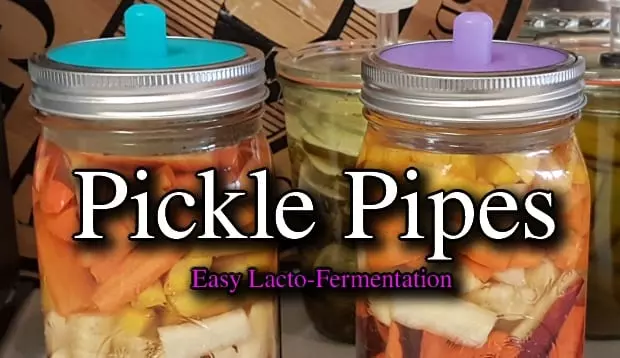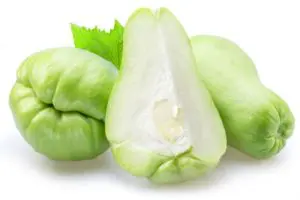I've literally only had my Pickle Pipes for 3 days and they're working for me already by helping me lacto ferment some organic, heirloom, homegrown rainbow carrots. How these silicone fermentation airlocks perform over the next several weeks will determine whether I decide to purchase more Pickle Pipes or not.

Fermenting rainbow carrots (image above)
I purchased my Pickle Pipes online in Australia from Nourishme Organics eBay store here as part of an overall fermentation kit which included: 3 x Pickle Pipes; 4 x Pickle Pebble glass fermentation weights; 3 x 950 mil Mason jars (including bands and lids); 1 x Pickle Packer (a wooden utensil used to pack/push produce into the jars or to pound cabbage to make sauerkraut); and a Masontops fermenting guide recipe book (via download).

My Pickle Pipe fermenting kit purchased online (image above)
Masontops in the USA (founded by Phil Barron and Mike Bacher) are the inventors of Pickle Pipes – they actually ran a Kickstarter campaign to initially fund the development, and they also make a range of products mainly centred around complementing the ever popular Mason Jar.
Naturally, American buyers can purchase these products at various online stores, such as Amazon here, far cheaper than us Aussies even though many of the items are made in China (closer to us). Nevertheless, my first impressions tells me the extra few dollars spent is worth it.
What are Pickle Pipes?
Essentially, Pickle Pipes are waterless airlocks made of silicone, specifically designed to fit the tops of wide mouthed Mason Jars.
What do Pickle Pipes do?
Well, if you're familiar with lacto fermentation (being a way to preserve produce and make tasty treats through fermenting) then you'll probably know the process of lacto fermenting requires an oxygen-free environment. That is, for the fermentation process to work correctly and for a wonderful sour delicacy, like sauerkraut or dill pickles to be created, the food must be fermented in an oxygen-free vessel whilst still being able to "breathe" or dispell carbon dioxide (CO2). Why? Because good bacteria (lactobacilli) thrive in an oxygen-free environment and bad bacteria need oxygen and since fermentation is a live food we want the good bacteria to win otherwise the food will spoil. Also, since the fermentation process creates CO2 gas we need a device on the vessel that will let this gas escape whilst still keeping oxygen from getting in because obviously if the build-up of gas is not released the jar or container could explode.
In short, after that rather long explanation, Pickle Pipes allow CO2 to escape from the vessel without letting oxygen in making this essential task of lacto fermenting food rather easy.
The main features of Pickle Pipes
There are several features claimed by the makers and sellers of Pickle Pipes that enticed me to test out the product for myself and these are:
- One way valve – At the top of the list because if this valve didn't work you wouldn't have a product. And, as far as valves go this is basically just a small silicon nipple with a cross cut in the top that opens when the pressure builds up and releases the gas, overall it's an extremely simple mechanism! I did note a warning on the packaging when I opened the box containing my Pickle Pipes instructing that the nipple be squeezed to ensure the valve did open before first use. I suspect this is a standard precaution taken to ensure the nipple cross cut valve was punched out properly during mass manufacturing – I'd imagine with such a design and material that the odd valve might be still sealed but a gentle squeeze fixes it easily. So far, I've seen no issues at all with mine.

- No water required – This airlock design does not require water. For those who lacto ferment regularly, you'd know how the standard airlocks require water to work correctly. Even the old European sauerkraut clay crocks have a moat around the lid, which is filled with water acting as an airlock. The problem with water airlocks is remembering to keep the water topped up otherwise if left to evaporate your ferment could perish. Also, standard plastic airlocks do need extra cleaning and are generally made of several parts including a hole in the container lid with a grommet.
- BPA-free silicone – Means the product is free from potentially harmful bisphenol, which may be harmful over time when inadvertently consumed due to this substance leaching out of the silicon or plastic product. I guess this is a good thing but I'd expect most food handling products to be BPA-free nowadays.
- Low profile – They do have a low profile and are, therefore, easier to store because they take up less head space.
- Easy to use – Most definitely easier to use than other airlocks! They're easy to fit, easy to clean by hand wash, and are dishwasher safe.
- Economical – Not too sure about this claim… Masontops say their Pickle Pipes are up to 70% less expensive than most current airlocks; however, a standard common plastic airlock retails for just a few dollars whereas a single Pickle Pipe airlock will cost between $5 to $10. Just off the cuff, I would expect both the old style airlocks and the Pickle Pipes to have a similar lifespan.
- Eco-friendly – The fact that a product can be reused over and over is good; although, I do think it's a bit of a stretch to call it a major product feature.
What are some drawbacks when using Pickle Pipes?
The fact that Pickle Pipes only fit wide-mouth Mason Jars could be seen as a drawback or limiting for some people who have other jar type collections. I have also read comments about some people finding the airlock vent crusting over or clogging up due to the bubbling ferment. However, this is just hearsay on my part and not something I have seen yet. Plus, I would question if the bubbling out of the vent hole was mainly due to the jar being overfilled in the first place.
Whilst I'm very happy so far with the performance of my Pickle Pipes, I'll still keep an open mind and intend to update this article if I find any issues concerning the use of this particular airlock.
What's the big deal about waterless airlocks?
As I mentioned above in the "features," waterless airlocks were an obvious evolution to water filled airlocks born out of convenience. Airlocks that use water still do a great job, but as I explained earlier they do require monitoring and extra maintenance.
Pickle Pipes simply fit onto the top of the jar and don't require the modification of existing jar lids like other airlocks do; such as, drilling a hole and inserting a grommet to fit.

An example of Pickle Pipes compared to standard water airlocks (image above)
What other information have I found out about Pickle Pipes?
The Pickle Pipe is a fairly recent product barely 12 months old, as at the writing of this article. The Kickstarter campaign by Masontops towards the end of 2015 raised nearly 200k over 15 times more than the initial goal!
Where can I buy Pickle Pipes?
Pickle Pipes can be purchased individually or in ferment kits of various arrangements and although this product isn't overly popular yet it's still quite obtainable if you search around. The best places I have found are as follows:
- Australia: eBay AU, and Nourish Me Organics.
- USA: Amazon USA, eBay USA, and Masontops.
- UK: Amazon UK, and eBay UK.
You might like to read my article: How and Why to Make Lacto-Fermented Mixed Vegetables (with a recipe included) for some more inspiration/information on lacto fermenting vegetables.














